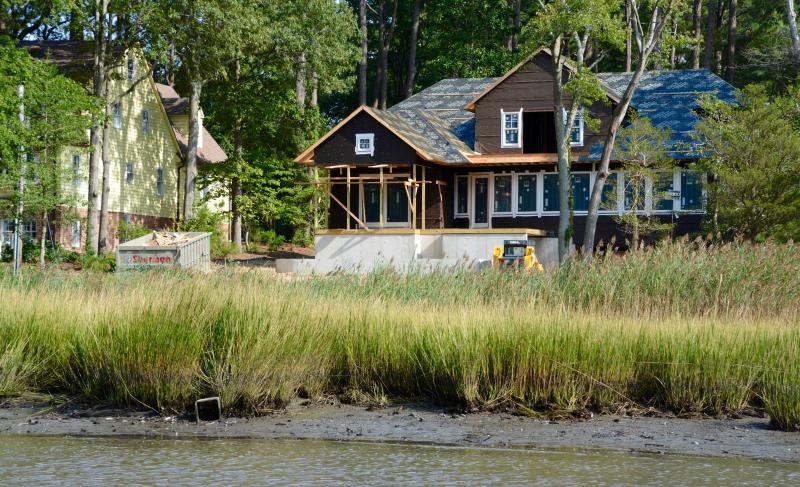During a workshop on Sussex County's wetland buffer regulations, it become obvious early on that the current ordinance contains ambiguities and loopholes.
County staff met with county council and the planning and zoning commissioners Sept. 18 in a joint workshop to discuss the ordinance at the request of Councilman I.G. Burton, R-Lewes.
Under current regulations, the county requires a 50-foot minimum buffer along tidal wetlands and tributary rivers and streams. A buffer is not required along nontidal wetlands, farm ponds, tax ditches and other man-made bodies of water.
Burton said Sussex County's regulations do not come close to matching neighboring states where most tidal wetland buffers range from 100 to 300 feet. Other states also have regulations for nontidal wetlands.
Burton said wetland buffers have not been studied in a long time. “We need to gather the facts, look at where we are now and where will be in the future,” he said. “We can no longer act like things have not changed.” He acknowledged that any changes would be complicated and affect a lot of property owners.
“The wider the better,” said Delaware Center for the Inland Bays Executive Director Chris Bason, who helped coordinate the workshop. “There is no question wider buffers help water quality.”
He said the center recommends a minimum 80-foot buffer.
Issues with county ordinance
Councilman George Cole, R-Ocean View, asked whether a wetland buffer could be part of an approved property line within a lot in a subdivision.
Assistant county attorney Vince Robertson answered yes but said planning and zoning commissioners typically do not allow the practice during site-plan review, and the areas are typically maintained by homeowners associations.
“In practice, the bar is set very high,” said Planning and Zoning Chairman Bob Wheatley. “It's not the preferred way of doing things.” However, Robertson said, it's not specifically mentioned in the code that HOAs are responsible for maintaining wetland buffers. “It should be clearly stated; it should be part of code. It needs to be clearer,” Cole said. “It can't be policy; it has to be in the ordinance.”
“That's why we are here,” said County Administrator Todd Lawson.
In the current ordinance it's not clear whether developers are permitted to clearcut existing trees in buffer areas and then re-establish the buffer, or are required to leave trees intact during development of a site.
Officials said it's preferred that developers leave trees intact. “But there is nothing to prevent clearcutting,” Cole said.
There are also no requirements for the same type of buffer to be re-established. Robertson said any kind of vegetation can be used, including grass.
Bason said some developers are clearcutting existing vegetation along wetlands. “That's misinterpreting the spirit of the ordinance,” he said. “They are supposed to leave existing vegetation in the buffer zone. It needs clarification.”
“What can we do so it's not done again? Shut them down?” asked Councilman Rob Arlett, R-Frankford.
“We don't have a buffer enforcement officer in Sussex County,” said county engineer Hans Medlarz. “Enforcement has not been clearly defined.”
“Follow-through has been inconsistent,” Lawson said.
Officials also questioned whether state officials could dictate buffer widths as is done in neighboring states.
“Yes, the state can do it,” county attorney J. Everett Moore said.
He said the lawsuit the county won when the state tried to dictate 100-foot buffers was tied to the administrative procedures used and not the actual buffer regulation. “They did not go through the proper process,” Moore said.
Love Creek buffers working
Arlett said lots of money has been spent on cleaning up Chesapeake Bay. “Is it working?” he asked.
Bason said reports show the bay is showing a huge rebound. “Bay grasses, which are key to the ecosystem, are returning. Things are working in the Chesapeake.”
He said wider buffers with forests, such as those along Love Creek, are ideal. Love Creek is one of the last waterways in the Inland Bays watershed with living bay grasses, which are breeding grounds for crabs and fish, he said.
Bason said while goals for reducing phosphorous in the Inland Bays have been met, thanks in part to the expansion of county central sewer, the goal for reducing nitrogen is only at 38 percent.
He said voluntary programs are in place to reduce nitrogen, including the planting of cover crops, but there needs to be more investment from state and county officials
“We have a long way to go, and wider buffers is one way to help get there,” he said.
“Wetlands are a treasure to be protected and not a burden,” Cole said. “Developers get higher value for land adjacent to wetlands.”
Wetlands provide many benefits
Bason said wetland buffers aid in pollution control, protect groundwater and remove nitrates, which are causing the most problems in the Inland Bays.
They also help keep sediment out of waterways and provide habitat for wildlife to breed.
Bason also pointed out that protecting wetlands provides an economic benefit for the county’s important tourism industry.
Bason said salt marshes are in a continuous state of moving inland. More room – in the form of wider buffers – gives the marshes room to expand and determines how long they survive, Bason said.
“I thought the workshop was the beginning to visiting a code that needs to be visited,” Burton said following the meeting. “There seems to be consensus to look at our current code in congruence with maintaining economic values, which sounds like a good approach to me.”
Lawson said he would present a list of action items to council for possible future agenda items.
Council has items to consider
Following the workshop, County Administrator Todd Lawson provided the following take-away items for council to consider:
The code should clearly state that buffers are outside property lines.
It should be clarified that buffers are not required from tax ditches or other man-made bodies of water.
Correct the current definition of buffer zone to eliminate the choice between maintaining a naturally vegetated buffer or creating a new area of established vegetation.
Add a requirement that streams and nontidal wetlands areas not be disturbed.
Review the cluster ordinance and environmentally sensitive developing district overlay zone design standards to emphasize buffers in subdivision design to provide an appropriate amount of open space to create wetland buffers rather than internal open space in a subdivision.
Possible incentives for larger buffers and better use of open space.
Create a buffer plan while maintaining the economic value of the land.


















































